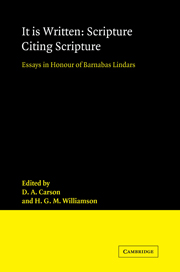Book contents
- Frontmatter
- Contents
- Preface
- Biographical note
- Abbreviations
- 1 An assessment of recent developments
- THE OLD TESTAMENT IN THE OLD TESTAMENT
- BETWEEN THE TESTAMENTS
- 6 Translating the Old Testament
- 7 Retelling the Old Testament
- 8 Commenting on the Old Testament
- 9 Citing the Old Testament
- 10 Apocalyptic literature
- THE OLD TESTAMENT IN THE NEW TESTAMENT
- Indexes
10 - Apocalyptic literature
Published online by Cambridge University Press: 16 January 2010
- Frontmatter
- Contents
- Preface
- Biographical note
- Abbreviations
- 1 An assessment of recent developments
- THE OLD TESTAMENT IN THE OLD TESTAMENT
- BETWEEN THE TESTAMENTS
- 6 Translating the Old Testament
- 7 Retelling the Old Testament
- 8 Commenting on the Old Testament
- 9 Citing the Old Testament
- 10 Apocalyptic literature
- THE OLD TESTAMENT IN THE NEW TESTAMENT
- Indexes
Summary
The fact that Scripture is quoted explicitly so infrequently in the apocalypses should not lead us to suppose that the whole process of scriptural interpretation was a matter of little or no concern to the writers of the apocalypses and the unknown visionaries concealed behind them. Those who have studied the book of Revelation will know that, while it may be true to say that Scripture is not formally cited by the author, allusion to the Bible is to be found in virtually every verse. The extant Jewish apocalypses do not set out to make obvious connexions with particular biblical passages (Stone, 1984, p. 390). However, the absence of such clearcut connexions should not lead us to suppose that the material has only tenuous links with the Scriptures, for the apocalypses do not set out to be in the first instance biblical commentaries. The links that there are will frequently be allusive and indirect. Thus an analysis of the way in which Scripture is used needs to follow a more subtle approach, allowing full weight to the often allusive character of reference to Scripture and the complexity of the relationship.
But first it is necessary to specify which works will be considered as examples of apocalypses. There has been much discussion recently about the genre of the apocalypse (see Collins, 1979, and Rowland, 1982), from which there has emerged a surprising amount of agreement on which works should be included within the corpus of apocalyptic literature. There has been debate about the status of the Sibylline Oracles and the book of Jubilees.
- Type
- Chapter
- Information
- It Is Written: Scripture Citing ScriptureEssays in Honour of Barnabas Lindars, SSF, pp. 170 - 190Publisher: Cambridge University PressPrint publication year: 1988
- 3
- Cited by



